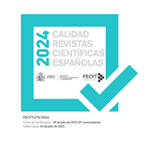Research on the Trends and Hot Topics of American Applied Linguistics: Analysis of the Changes of Strands and High-Frequency Words in AAAL Annual Conferences from 1999 to 2019
Resumen
This paper aims to explore the trends and hot topics of American applied linguistics by the content analysis of AAAL annual conferences’ handbooks. Making a diachronic research on topical strands of AAAL Conference from 1999 to 2019, the paper studies the dynamics and the trends of American applied linguistics by analyzing the changes of the strands in the conferences under study in 20 years. Based on self-built corpora of titles and abstracts of the presented papers in 2019 AAAL Annual Conference, high-frequency vocabulary and their collocations are detected by TagCrowd and AntConc in order to find the current hot topics of applied linguistics research. The conclusion is that the development of applied linguistics has speeded up in the past four years. Educational linguistics, corpus linguistics, research methodology, teacher education, lexical research, phonetics/phonology and oral communication are the new trends in this field. The hot words of applied linguistics in 2019 include academic writing, teacher education, Chinese and translanguaging. Finally, the study found that retrospective review study of international conferences could be a new research method in the field of review study, providing scholars with a comprehensive understanding of the discipline dynamics over a period of time
Descargas
Descarga artículo
Licencia
La revista Círculo de Lingüística Aplicada a la Comunicación, para fomentar el intercambio global del conocimiento, facilita el acceso sin restricciones a sus contenidos desde el momento de su publicación en la presente edición electrónica, y por eso es una revista de acceso abierto. Los originales publicados en esta revista son propiedad de la Universidad Complutense de Madrid y es obligatorio citar su procedencia en cualquier reproducción total o parcial. Todos los contenidos se distribuyen bajo una licencia de uso y distribución Creative Commons Reconocimiento 4.0 (CC BY 4.0). Esta circunstancia ha de hacerse constar expresamente de esta forma cuando sea necesario. Puede consultar la versión informativa y el texto legal de la licencia.











